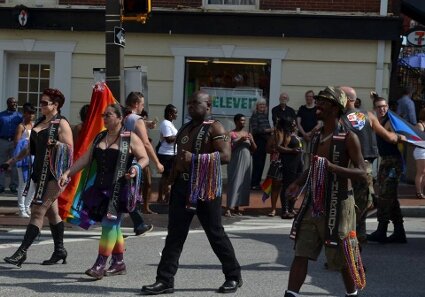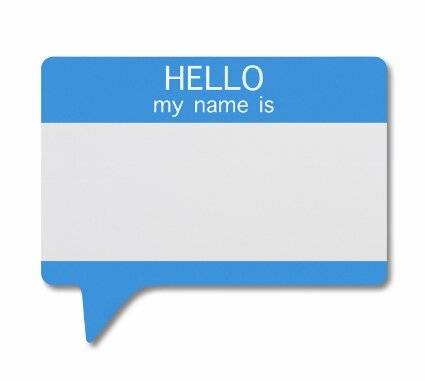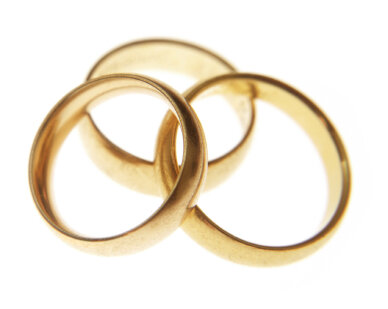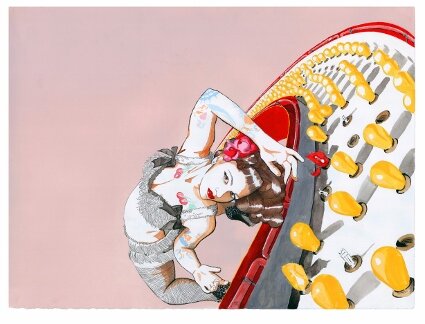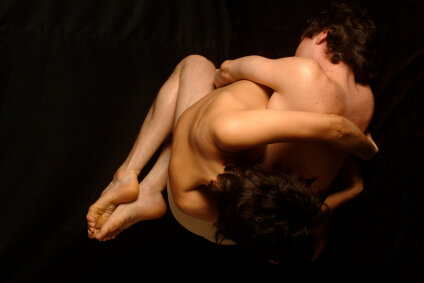Viola 24, Female, Gay, Available.
Looking For: Gay Women.
Interested In: short term dating, long term dating, friendship.
“No men, no couples.”
I am on OkCupid. While I don’t specify that I’m poly, I list myself as “available” instead of “single” and made a point to answer all of the kink-related questions so that the little picture of the dominatrixesque butt shows up on my profile to act as a filter. I specify “no men, no couples.”
While my profile isn’t very active (I check it maybe once a month), there are usually a few messages in my inbox when I get around to signing in. When I was single, my inbox was a little collection of winks and short one-line flirty notes, but that’s no longer the case. Viola, 24, Gay, Available is frequently propositioned for a menage a trois with married couples in the ‘burbs. Such notes go something like this:
“My husband and I have been married for 10 years and we want to add a third to the bedroom occasionally! His biggest fantasy is watching me have sex with a lesbian, and then joining us, and I want to make it happen for our anniversary!”
(There are usually exclamation points, a flurry of them to indicate to me that I should be very, very excited. Little do they know that I perfected sarcasm while watching Daria in the 9th grade, and such exuberance immediately triggers an eye-roll.)
Replies are usually a standard “thanks, but no thanks, I’m flattered but not interested,” because a treatise on the rules regarding inviting queer femme dykes to join your heterosexual union for a night in the sack would be too long, complicated, and bizarre. But here it is, the full and complete analysis of why it’s usually not okay to proposition queer femme dykes who specify “no men, no couples” on their online dating profiles.
When I originally wrote this particular column, I was fuming and it was akin to a Dan Savage blog post. It has since been cleaned up for the sake of not appealing to the lowest common denominator.
My orientation presents an issue. I’m actually unapologetically attracted to female bodied people exclusively, and somewhere near a 6 on the Kinsey scale. Unless otherwise specified, the general understanding of “female, gay, available” is that the person in question identifies as a woman, and sleeps primarily with female-bodied and/or female identified people, and has little to no desire to get it on with your husband.* It’s a reasonable assumption.
Which brings us to the specific request of our lovely suburbanites wanting to add some spice to the boudoir.
I find it offensive when people ask queers to sleep with them as a form of experimentation or exotic thrill. Somehow I don’t think I would get such propositions if I asserted that I was “heteroflexible,” as usually the message contains a line akin to “my husband has always wanted to watch me sleep with a lesbian” or one asserting a secret, taboo bisexuality that has yet to be explored.
This is more than a “my kinks aren’t your kinks” issue — by propositioning me for a threesome with your husband, one is essentially positing that my preferences, specified clearly and spelled out neatly, could possibly be discarded in favor of cultivating your sex life. It also feels very much like I am your fetish, and not a person. I am not an exotic side-dish to add flavor to your suburbanite sex life, nor am I offering up my mad hot sexy skills to be your marital aid. Assumptions along those lines based on my orientation are absurd.
What the drop-down menu doesn’t allow me to specify is that being female isn’t enough to make me want to sleep with someone. My sexuality isn’t necessarily fluid, and I’m okay with that. I imagine that at least one person reading this would love to dispute such assertions, either within the context of keeping an open mind or that because I am currently seeing/sleeping with a non-op non-hormone trans-identified female bodied person, my dyke identification either invalidates his identity, conflicts with my orientation, or both. (Note: I am not referring to my partner, G. She does not identify as trans.) My orientation and identity may sometimes require footnotes, but that doesn’t mean the physical realities of my attraction to other consenting, female bodied adults needs to change on a whim. And yes, the guy with XX chromosomes is cool with it, too.
Being queer, though, manifests itself in more than who I sleep with. Understanding what queerness means within our society and culture both informs and directs the way I approach the world. To step outside of the protections of heterosexual, heteronormative privilege is to entangle one’s self with an alternate means of examining our culture. I struggled to come out because I knew, without being able to phrase it as I am able to do now, that I would lose heterosexual privilege so ingrained into daily life that it goes unnoticed so many times.
So no, I don’t want to sleep with you while your husband watches. I don’t want to be your lesbian fantasy, and I’m not actually flattered but I’ll tell you so because rejection hurts and you seem sweet, stranger who just invited me to join you in bed. If you wouldn’t walk up to a me in the supermarket and ask for this incredibly personal favor, it’s not appropriate for you to do so from behind the safety of the family Dell, and my orientation doesn’t change that. Think about it — would you, hypothetical married 30-something straight woman in the suburbs, approach the person in my picture in the cereal aisle at Shaw’s to tell her that your husband (the guy with the beard near the canned soups) has always wanted to watch you sleep with a lesbian, and that you think I’d be perfect? I certainly hope not. Don’t even think about how rude it would be to say that I’d be a good fit because he thinks “those butch ones” are unattractive but I’m not threatening. (You might say it with a wink, because it’s just between us girls.) A fairly vanilla dating site with quite a few queer-identified graduate students is also not necessarily the proper venue, either. Wanting to go on a date is very different than wanting to sexually perform for your husband.
I’m queer, female, poly, and usually up for some sane, safe, consensual fun after I get out of the library, but that doesn’t mean I want it with the world. Being poly doesn’t mean that I lack preferences — in fact, it doesn’t even rule out pickiness. Being queer doesn’t mean that I think you’re hot. It also shouldn’t give strangers the idea that I want to sleep with them to help them fulfill their fantasies, fantasies I am not personally invested in, nor do I truly care about. I like to think that I am, as Dan Savage puts it, good, giving, and game, which requires one to care about their partner’s well-being — but that doesn’t mean that I am required to personally invest in making your fantasies come true, kind stranger, nor does it provide that I should.
*Yes, there are queer variations on the theme, and okcupid doesn’t list “queer” as an orientation. The intricacies of queer politics and the normative assumptions made by the nice people at okcupid are not the focus of this particular piece of writing, though there is a definite case to be made for better queer, comprehensive standards on dating sites.
Originally posted on February 2, 2011
 Sometimes culturally established practices conflict with sound sexual health imperatives. Nowhere is this clash more obvious than in the touchy issue of circumcision in general, and infant circumcision in particular.
Sometimes culturally established practices conflict with sound sexual health imperatives. Nowhere is this clash more obvious than in the touchy issue of circumcision in general, and infant circumcision in particular.
